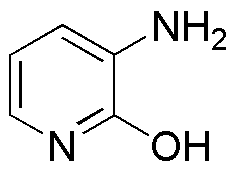3-Amino-2-hydroxypyridine is widely utilized in research focused on:
- Pharmaceutical Development: This compound serves as a key intermediate in the synthesis of various pharmaceuticals, particularly those targeting neurological disorders. Its unique structure allows for the modification of drug properties, enhancing efficacy and reducing side effects.
- Agricultural Chemicals: It is used in the formulation of agrochemicals, acting as a building block for herbicides and fungicides. This application helps improve crop yields and protect plants from diseases, contributing to sustainable agriculture.
- Material Science: The compound is explored for its potential in creating advanced materials, such as polymers and coatings. Its properties can enhance durability and resistance to environmental factors, making it valuable in construction and manufacturing.
- Biochemical Research: Researchers utilize it as a reagent in various biochemical assays, aiding in the study of enzyme activity and metabolic pathways. This application is crucial for understanding biological processes and developing new therapeutic strategies.
- Analytical Chemistry: It is employed in analytical methods for detecting and quantifying other compounds. Its ability to form stable complexes with metal ions makes it useful in environmental monitoring and quality control in various industries.
General Information
Properties
Safety and Regulations
Applications
3-Amino-2-hydroxypyridine is widely utilized in research focused on:
- Pharmaceutical Development: This compound serves as a key intermediate in the synthesis of various pharmaceuticals, particularly those targeting neurological disorders. Its unique structure allows for the modification of drug properties, enhancing efficacy and reducing side effects.
- Agricultural Chemicals: It is used in the formulation of agrochemicals, acting as a building block for herbicides and fungicides. This application helps improve crop yields and protect plants from diseases, contributing to sustainable agriculture.
- Material Science: The compound is explored for its potential in creating advanced materials, such as polymers and coatings. Its properties can enhance durability and resistance to environmental factors, making it valuable in construction and manufacturing.
- Biochemical Research: Researchers utilize it as a reagent in various biochemical assays, aiding in the study of enzyme activity and metabolic pathways. This application is crucial for understanding biological processes and developing new therapeutic strategies.
- Analytical Chemistry: It is employed in analytical methods for detecting and quantifying other compounds. Its ability to form stable complexes with metal ions makes it useful in environmental monitoring and quality control in various industries.
Documents
Safety Data Sheets (SDS)
The SDS provides comprehensive safety information on handling, storage, and disposal of the product.
Product Specification (PS)
The PS provides a comprehensive breakdown of the product’s properties, including chemical composition, physical state, purity, and storage requirements. It also details acceptable quality ranges and the product's intended applications.
Certificates of Analysis (COA)
Search for Certificates of Analysis (COA) by entering the products Lot Number. Lot and Batch Numbers can be found on a product’s label following the words ‘Lot’ or ‘Batch’.
*Catalog Number
*Lot Number
Certificates Of Origin (COO)
This COO confirms the country where the product was manufactured, and also details the materials and components used in it and whether it is derived from natural, synthetic, or other specific sources. This certificate may be required for customs, trade, and regulatory compliance.
*Catalog Number
*Lot Number
Safety Data Sheets (SDS)
The SDS provides comprehensive safety information on handling, storage, and disposal of the product.
DownloadProduct Specification (PS)
The PS provides a comprehensive breakdown of the product’s properties, including chemical composition, physical state, purity, and storage requirements. It also details acceptable quality ranges and the product's intended applications.
DownloadCertificates of Analysis (COA)
Search for Certificates of Analysis (COA) by entering the products Lot Number. Lot and Batch Numbers can be found on a product’s label following the words ‘Lot’ or ‘Batch’.
*Catalog Number
*Lot Number
Certificates Of Origin (COO)
This COO confirms the country where the product was manufactured, and also details the materials and components used in it and whether it is derived from natural, synthetic, or other specific sources. This certificate may be required for customs, trade, and regulatory compliance.


